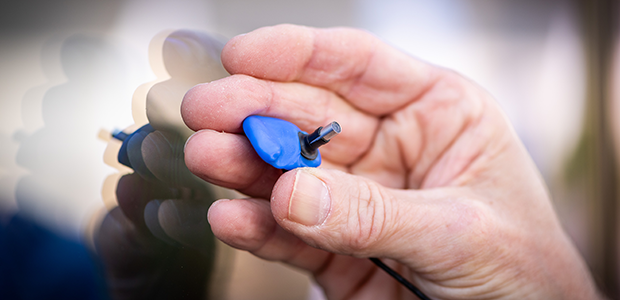
EarSwitch in-ear communication device showcased at CES
EarSwitch, a startup leveraging University of Bath's research, is presenting a novel wearable device at CES.
This innovative product is designed to aid communication for individuals with disabilities, including motor neurone disease (MND, also known as ALS).
The company's latest offering, EarControl, is an assistive technology showcased at the Las Vegas event. The EarSwitch device, resembling an earbud, is inserted into the ear and utilises a built-in sensor to detect movements of the tensor tympani muscle. This feature enables users to operate an assistive keyboard by tensing the muscle to select letters and words on a screen.
The tensor tympani muscle, typically activated during yawning, was discovered by the research team to be voluntarily controllable by many individuals, with potential for further training. EarControl functions as a 3D ‘ear mouse’, allowing users who are unable to use standard input devices to interact with computers by selecting icons on a connected device's screen with an ear click. This is possible because the tensor tympani muscle’s movement is linked to eye movement.
The technology holds promise for prolonged support in degenerative conditions like MND, where the tensor tympani muscle's control tends to be retained longer than other muscles. Beyond aiding people with neurological conditions, the team envisages applications in mobile phone controls and gaming.
EarSwitch, conceptualized by former Somerset GP Dr. Nick Gompertz, is a collaborative effort with Bath University experts from computer science, electronic engineering, and health domains. In 2022, EarSwitch secured over £1.5 million from the National Institute for Health and Care Research (NIHR) for development and regulatory approval as a medical device, and to investigate its use in controlling upper-limb exoskeletons or prostheses.
Dr. Nick Gompertz remarks on the collaboration with the University of Bath: “The collaboration with University of Bath continues to be pivotal in the advancement of EarSwitch to improve communication for people with conditions such as MND (also known as ALS). The importance of this opportunity has been recognised by the Scott-Morgan Foundation (SMF) with whom we will be demonstrating EarControl as part of a collaborative of assistive technologies at CES. We are working with SMF to give everyone the Right to Thrive.”
The Bath team includes Dr. Ben Metcalfe, Dr. Dario Cazzola, and Dr. Chris Clarke. Dr. Ben Metcalfe, Deputy Director of the Bath Institute for the Augmented Human, expresses his delight: “We are delighted that EarSwitch continues to go from strength to strength, and their recent showing at CES 2024 demonstrates their remarkable achievements over the past few years. The EarSwitch technology has the potential to transform the quality of life of those living with conditions such as motor neurone disease, and it is so pleasing to see that this work continues in the spirit of Peter Scott-Morgan and the Scott-Morgan Foundation. Developing a new medical device is a complex process, and we continue to support EarSwitch with both core technology development and ongoing clinical trials required for full regulatory approval. It is a real pleasure to see such continued success from Nick and the team.”
This collaboration with Dr. Gompertz is a product of the University’s Digital Innovation Business Acceleration Hub, backed by ERDF, and the SETsquared Scale-Up programme.

